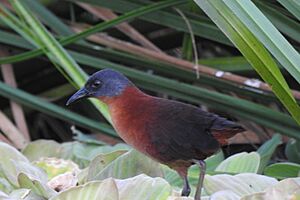Ruddy crake facts for kids
Quick facts for kids Ruddy crake |
|
|---|---|
 |
|
| Conservation status | |
| Scientific classification | |
| Genus: |
Laterallus
|
| Species: |
ruber
|
 |
|
The ruddy crake (Laterallus ruber) is a small bird that belongs to the rail family, called Rallidae. People also know this bird as the "red rail," "ruddy rail," or "red crake." It lives in wet areas in parts of Central America.
Contents
About the Ruddy Crake
The ruddy crake is easy to spot because of its reddish feathers. The color can change a bit from one bird to another. Its head is usually gray, and its wings and tail are dark brown. Most of its body is a bright chestnut color. Its chin and belly are lighter, and it has a blackish top of the head. The feathers around its ears are dark gray.
Ruddy crakes are about the size of a sparrow, which means they are quite small. They are usually 14 to 16.5 centimeters long. Young ruddy crakes might have lighter colors on their neck or back. The bird has a black beak, red eyes, and olive-green legs and feet. These yellow-green legs help tell them apart from other small birds. Their feet are wide, which is perfect for walking in wet places. Male ruddy crakes usually have brighter reddish feathers on their chest than females.
Where They Live
Ruddy crakes love wet places, just like other birds in the Rallidae family. They prefer wet fields and marshes, especially areas with tall grasses. You can find them in the lowlands of the Caribbean, including parts of Mexico, the Yucatan Peninsula, and Honduras. They live from Mexico all the way south to northwestern Costa Rica. They are found in places like marshes, reedbeds, damp fields, and ditches.
In the 1960s and 1970s, many ruddy crakes lived in Mexico. However, they were considered rare in Costa Rica. For about 20 years, people in Costa Rica didn't see any ruddy crakes, and some thought they might have disappeared from the area. But in May 2007, a ruddy crake was seen near a research station. This sighting showed that they are still around and spread out over a wide area.
Behavior and Life
What They Eat
The ruddy crake finds its food near the surface of the water in wetlands. They eat small creatures without backbones, like water snails, water beetles, mosquito larvae, and mayflies. They also eat parts of decaying plants.
Reproduction and Life Cycle
Ruddy crakes build their nests near water using plants. A female crake usually lays between 6 and 12 eggs. Both the male and female birds take turns sitting on the eggs to keep them warm. This takes about three weeks. The eggs hatch over a period of about a week.
When the chicks hatch, the male parent often takes care of the older chicks while the female continues to sit on any younger eggs that haven't hatched yet. Once all the eggs have hatched, both parents work together to feed and protect their young. Sometimes, the chicks are split up, with each parent looking after a group of them.
Protecting the Ruddy Crake
Population Numbers
The number of ruddy crakes has gone down because of deforestation (cutting down forests) and damage to their homes. However, efforts by governments and groups that protect nature have helped the species. One organization, Partners in Flight, believes there are fewer than 50,000 ruddy crakes in total. It's hard to know if their numbers are still going down because we don't fully understand all the dangers they face.
Conservation Status
The ruddy crake's conservation status is currently listed as "Least Concern." This means that while their population might be affected by some threats, they are not currently considered to be in danger of disappearing.
How They Are Classified
The old Latin name for the ruddy crake was "Corethrura rubra."


